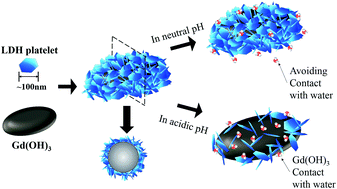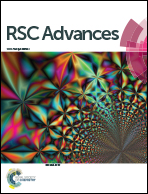Finely crafted quasi-core–shell gadolinium/layered double hydroxide hybrids for switching on/off bimodal CT/MRI contrasting nanodiagnostic platforms†
Abstract
We successfully synthesized a size-controlled hybrid of layered double hydroxide (LDH) platelets and Gd(OH)3 nanorods through the reverse micelle method. Under controlled synthetic conditions, the hybrid was developed to a quasi-core–shell structure, where the Gd(OH)3 nanorods were covered by the LDH platelet assembly, and this was investigated by X-ray diffraction and high-resolution transmission electron microscopy. The zeta potential measurement for the hybrid revealed that Gd(OH)3 was surrounded by LDH moieties. According to dynamic light scattering, the hydrodynamic radius of the hybrid was uniformly controlled under 150 nm, which was comparable to that of one Gd(OH)3 nanorod surrounded by an LDH moiety. Thus, the obtained hybrid exhibited a maximum Hounsfield unit of 180 at a concentration of 5 mg mL−1, implying its potential as a computed tomography contrast agent. The magnetic resonance relaxivities of the hybrid were examined at pH 5 and 7, simulating lysosomal and plasma conditions; the r1 values were 7.3 and 2.9, respectively, which were highly dependent on the physiological conditions.



 Please wait while we load your content...
Please wait while we load your content...